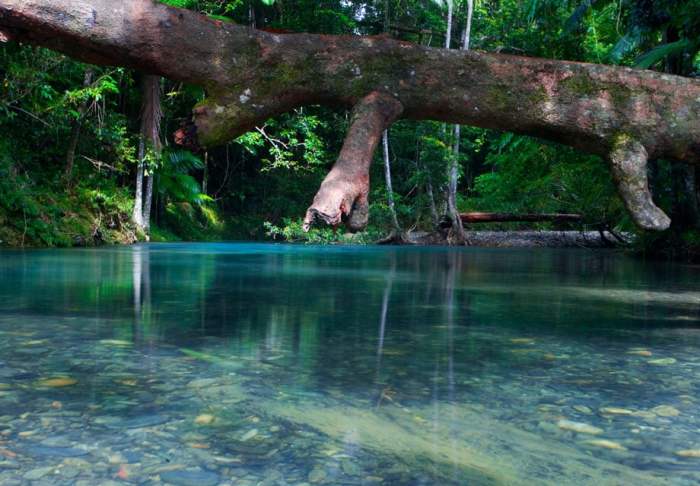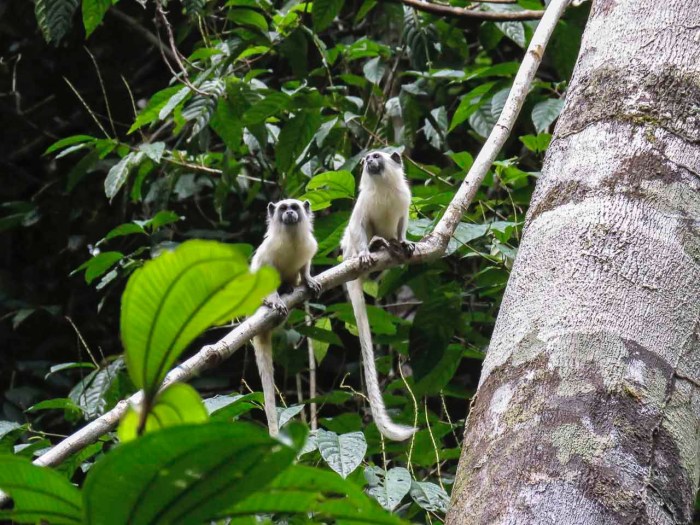
Embark on a wild adventure as we uncover the top wildlife experiences in rainforests, where nature’s wonders await at every turn. From vibrant bird species to elusive jungle cats, get ready for an immersive journey like no other!
Discover the hidden gems of rainforest wildlife and the crucial role these ecosystems play in supporting a myriad of species.
Top wildlife experiences in rainforests
Rainforests are home to a diverse array of wildlife, ranging from colorful birds and exotic insects to majestic big cats and primates. The lush and dense vegetation of rainforests provides the perfect habitat for these animals to thrive.The importance of rainforests for wildlife conservation cannot be overstated. These ecosystems serve as crucial biodiversity hotspots, supporting a wide variety of plant and animal species.
Many of these species are endemic to specific rainforest regions, meaning they are found nowhere else on Earth. Protecting rainforests is essential to preserving these unique creatures and ensuring their survival for future generations.
Diversity of wildlife found in rainforests
- Rainforests are home to a multitude of bird species, including toucans, parrots, and hummingbirds, known for their vibrant colors and distinctive calls.
- Primates such as chimpanzees, orangutans, and howler monkeys swing through the trees of rainforests, showcasing their agility and intelligence.
- Giant anteaters, jaguars, and sloths roam the forest floor, each playing a vital role in the ecosystem’s balance.
Unique wildlife encounters in rainforest settings
- Witnessing a family of orangutans building nests in the treetops of Borneo’s rainforests is a once-in-a-lifetime experience that showcases their incredible adaptability.
- Spotting a resplendent quetzal, with its iridescent green and red plumage, flitting through the canopy of a Costa Rican rainforest is a sight to behold for any bird enthusiast.
- Coming across a majestic jaguar silently stalking its prey through the undergrowth of the Amazon rainforest is a thrilling encounter that highlights the raw power of these big cats.
Mountain Travel

When it comes to mountain travel, the wildlife species found in these high-altitude regions are truly fascinating. From the majestic snow leopard to the elusive Himalayan monal, there is a wide variety of unique creatures that call the mountains their home.Wildlife in mountainous regions has evolved and adapted to survive in harsh environments characterized by low oxygen levels, extreme temperatures, and rugged terrain.
Birds like the bar-headed goose have specialized lungs and hemoglobin that allow them to thrive at high altitudes, while mammals such as the Himalayan tahr have adapted to navigate steep slopes and rocky cliffs with ease.
Popular Wildlife Viewing Activities
- Spotting rare and endangered species such as the snow leopard and red panda in their natural habitats.
- Guided wildlife safaris and treks led by expert naturalists who can help you identify and learn about the local fauna.
- Birdwatching tours to catch a glimpse of unique avian species like the Himalayan monal and lammergeier.
- Exploring mountain trails and national parks to observe wildlife up close, such as bharal (blue sheep) and musk deer.
Desert Travel
Exploring the desert landscapes offers a unique and challenging experience when it comes to spotting wildlife. The vast, arid regions present obstacles such as extreme temperatures, limited water sources, and sparse vegetation, making it a tough environment for animals to survive in.
Despite the challenges, deserts are home to a variety of fascinating creatures that have adapted to the harsh conditions over time. Here are some interesting facts about desert-adapted animals:
Desert-Adapted Animals
- Camels are well-known for their ability to survive in the desert due to their specialized features such as humps that store fat for energy and water conservation.
- Fennec foxes have large ears that help dissipate heat and keen eyesight to hunt for prey in the sandy terrain.
- Thorny devils, native to Australia, have a unique way of collecting water through their skin by absorbing dew and raindrops.
- Desert tortoises can survive without water for long periods by storing it in their bladders and digging burrows to escape extreme temperatures.
Conservation Efforts
Conserving desert ecosystems is crucial to protecting the unique wildlife that calls these harsh environments home. Efforts are being made to preserve habitats, regulate human activities like mining and development, and raise awareness about the importance of desert conservation.
Arctic & Polar Travel
When it comes to Arctic and polar travel, one can expect to encounter a unique array of wildlife species that have adapted to survive in these extreme cold environments. From majestic polar bears to agile arctic foxes, the wildlife in these regions is truly captivating.
Unique Wildlife Species in Arctic and Polar Regions
- Polar Bears: These iconic creatures are well-known for their white fur and incredible swimming abilities.
- Arctic Foxes: With their thick fur coats, these foxes are perfectly suited to the freezing temperatures of the Arctic.
- Beluga Whales: These beautiful white whales can be spotted swimming gracefully in the icy waters of the Arctic.
- Walruses: Known for their large tusks and blubbery bodies, walruses are a common sight along the Arctic coastline.
Impact of Climate Change on Polar Wildlife
Climate change is having a profound impact on the wildlife in the Arctic and polar regions. The melting ice caps and warming temperatures are causing habitats to shrink, making it increasingly challenging for species like polar bears and seals to find food and raise their young. It is essential to address climate change to protect the fragile ecosystems of the Arctic.
Tips for Responsible Wildlife Viewing in Cold Environments
- Respect Wildlife: Maintain a safe distance from animals and never disturb their natural behavior.
- Stay Informed: Learn about the specific guidelines for wildlife viewing in the Arctic and follow them diligently.
- Dress Appropriately: Dress in warm layers to stay comfortable in the cold temperatures of the Arctic.
- Choose Eco-Friendly Tours: Opt for tours that prioritize sustainability and conservation efforts.
Jungle & Rainforest Travel

When it comes to jungle and rainforest travel, it’s essential to understand the unique ecosystems and wildlife encounters that await adventurers in these lush environments. Jungles are typically dense, tropical forests with high humidity and a variety of plant and animal species, while rainforests are characterized by heavy rainfall and a diverse range of flora and fauna. Both offer incredible opportunities for wildlife experiences and exploration.
Differences between Jungle and Rainforest Ecosystems
In jungles, travelers may encounter a mix of trees, shrubs, and vines, with a wide array of wildlife such as monkeys, birds, and insects. The dense vegetation and limited sunlight create a unique habitat for a variety of species to thrive. On the other hand, rainforests are known for their towering trees, including the iconic canopy layer that supports a complex ecosystem of plants and animals.
The constant rainfall in rainforests sustains a rich biodiversity, making them a hotspot for unique wildlife encounters.
Top Wildlife Experiences in Jungles and Rainforests
- Spotting elusive big cats like jaguars and leopards in the dense jungles of South America or Southeast Asia.
- Observing colorful bird species such as toucans, parrots, and macaws in the treetops of the Amazon rainforest.
- Encountering primates like monkeys and apes swinging through the trees in the jungles of Africa or Borneo.
- Discovering unique insect and amphibian species that thrive in the moist, tropical environment of rainforests.
Safety Tips for Encountering Wildlife in Dense Forest Environments
- Always maintain a safe distance from wild animals and avoid approaching them too closely.
- Respect the natural habitat of wildlife and refrain from feeding or disturbing them in any way.
- Follow local guidelines and regulations when exploring jungles and rainforests to ensure your safety and the well-being of the animals.
- Be mindful of your surroundings and listen to the guidance of experienced guides or rangers who can help navigate encounters with wildlife.
Coastal & Beach Travel
When it comes to coastal and beach travel, adventurers are treated to a vast array of wildlife encounters that are unique to these habitats. From diverse marine life to nesting sea turtles, these regions offer a rich biodiversity waiting to be explored.
Biodiversity of Coastal and Beach Habitats
Coastal and beach habitats are home to a wide variety of plant and animal species that have adapted to thrive in these dynamic environments. Mangrove forests, coral reefs, and sandy shores provide essential ecosystems for numerous marine and terrestrial creatures.
- Marine mammals such as dolphins, seals, and whales can often be spotted swimming along the coastlines.
- Birdwatchers will delight in the sight of seabirds like pelicans, albatrosses, and gulls soaring above the waves.
- Reptiles like sea turtles and iguanas make their nests on the beaches, offering a glimpse into their fascinating nesting habits.
Popular Wildlife Encounters for Beach Travelers
Beach travelers have the opportunity to witness incredible wildlife encounters that are unique to coastal regions. Whether snorkeling in crystal-clear waters or exploring sandy shores, there are plenty of unforgettable moments to be had.
- Swimming with colorful fish and sea turtles while snorkeling around coral reefs is a popular activity for beachgoers.
- Watching baby sea turtles hatch and make their way to the ocean under the watchful eyes of conservationists is a heartwarming experience.
- Joining guided wildlife tours to observe nesting seabirds and other coastal creatures up close provides valuable insights into their behavior.
Conservation Initiatives for Coastal Wildlife
Protecting coastal wildlife is essential to preserving the delicate balance of these ecosystems and ensuring the survival of vulnerable species. Conservation initiatives play a crucial role in safeguarding the habitats and wildlife that call coastal areas home.
- Beach clean-up efforts help remove plastic pollution and other marine debris that can harm marine life and seabirds.
- Establishing marine protected areas and implementing sustainable fishing practices are key strategies for conserving coastal habitats and biodiversity.
- Supporting local conservation organizations and eco-friendly tourism initiatives can contribute to the long-term protection of coastal wildlife and their habitats.
Closing Summary
As we wrap up our exploration of the top wildlife experiences in rainforests, remember to cherish and protect these precious habitats for future generations to enjoy. Dive into the heart of nature and let the enchanting world of rainforest wildlife captivate your senses!
FAQ Summary
What makes rainforests ideal for wildlife encounters?
Rainforests offer a rich tapestry of diverse habitats that support a wide array of wildlife species, creating the perfect setting for memorable encounters.
How can visitors ensure responsible wildlife viewing in rainforests?
Visitors can follow designated trails, maintain a safe distance from animals, and avoid feeding or touching wildlife to ensure a positive and sustainable experience.
Are there any endangered species commonly found in rainforests?
Yes, rainforests are home to many endangered species like orangutans, jaguars, and various bird species that rely on these habitats for survival.





